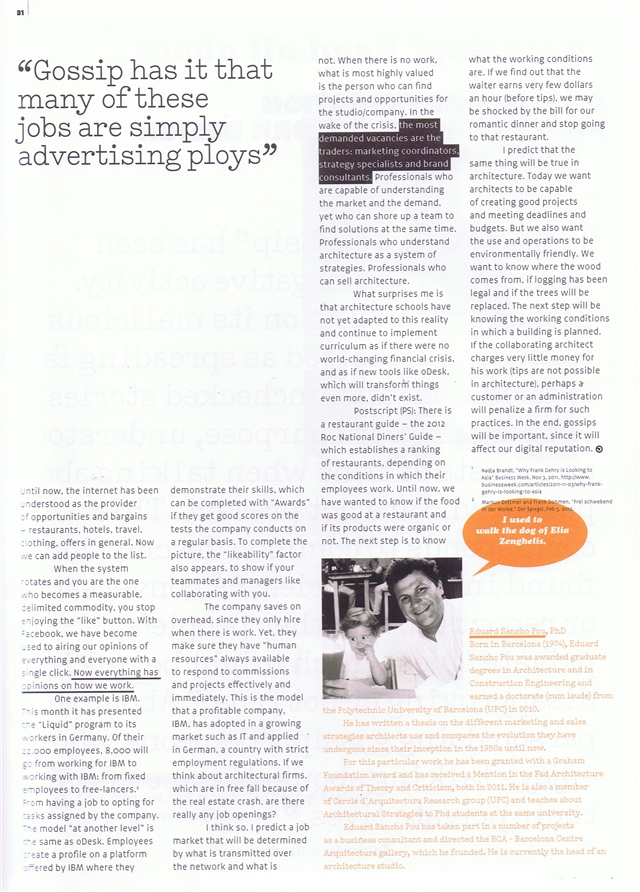Many firms are disappearing. Many firms are changing their way of working. Outsourcing is now standard use in architecture as well. In the same way that most call centres or IT managers in multinationals are in India or China, many architects move or hire rendering, calculation or delineation services outside the Western world. The reason: price competitiveness.
The problem is exacerbated when most projects are in countries such as China. Fees are paid based on a percentage of the construction prices, which in China are a third of what they are in the West.
“If you take a percentage and you work with western salaries, you can’t make it work,” Gehry said. “So it almost forces you to open an office in China and work with local people.” (Nadja Brandt – BusinessWeek: Oct 27, 2011)
If Gehry, with his awards and fame, cannot make the numbers work, it gives us an idea of what the situation is like in other firms. Disastrous. Everyone is talking about it; we all have colleagues who talk about layoffs, reduced working hours and a bleak professional future. Yet, even so, jobs are offered on specialized websites each month. More and more skills, more and more experience, more and more of everything is being demanded.
Gossip has it that many of these jobs are simply advertising ploys. Firms want to make a show of brand strength to their clients and competitors. The jobs are not posted because of hiring needs, but rather to size up the market. By viewing résumés, they can assess their competitors and identify opportunities. What they have worked on; who their customers are and above all, the resources available to them. A recently fired employee is someone who easily responds to questionnaires from a possible employer. And that information makes the cost of the selection process well worth it.
I am referring to people who have the experience and knowledge about the processes of the studio, the ways of contracting suppliers, and getting clients. I am referring to role postings that include so much detail about the offer that even candidates are surprised about it, as only very few people meet the requisition profile. What seems to be incredibly accidental, it really is an invitation to fill a questionnaire/interview/form that will allow that company to increase the knowledge about it’s competitor.
Today, firms tend to outsource more and hire less in order to avoid fixed expenses. In times of crisis, surviving depends directly on not having ballasts. These employees that leave and will not be replaced are these that plot lines, draw facilities and make renders. That is all production and operation roles, which in the near past used to be the entry roles for graduate and internship architects.
The change comes with oDesk, a hiring portal that recruits operational roles. There are not glamorous, but rather functional. And just as Google is a search engine for websites, oDesk is a search engine for people looking for work.
A host of professionals look for work in delineation, calculation, facilities, renders, anything else you can think of and more, with the only limit being that is transmitted through the Internet. All at a negotiable price, either by hour or by job. There are offers at $4.33 per hour Autocad. Or $39.50 for the rendering of a building (fixed price project). These prices are possible because those who monopolize the ratings rankings are professionals from developing countries such as India, the Philippines, Egypt and China. People who are hired on the basis of the level of satisfaction of other clients, but also scores (Top Scorers) of their professional skills.
oDesk offers the ability to test for knowledge of Autocad, 3DMax, Illustrator, etc ... which can then be added to one’s résumé. Academic qualifications are useless here; what counts is what one shows one can do under the search engine’s filter and parameters. Until now, the Internet has been understood as the provider of opportunities and bargains. Restaurants/hotels/travel/clothing offers. Now we can add the offer of people to the list.
When the system rotates and you are the one who becomes a measurable, delimited commodity, you stop enjoying the “like” button. With Facebook, we have become used to airing our opinions of everything and everyone with a single click. Now everything has opinions on how we work.
One example is IBM. This month it has presented the "Liquid" program to its workers in Germany. Of their 22,000 employees, 8,000 will go from working for IBM to working with IBM. From fixed employees to free-lancers. (Source: Frei schwebend in der Wolke "IBM Radikalreform" - Der Spiegel: Feb 05.2012). From having a job to opting for tasks assigned by the company. The model "at another level" is the same as oDesk. Employees create a profile on a platform offered by IBM, where they demonstrate their skills, which can be completed with "Awards" if they get good scores on the tests the company conducts on a regular basis. To complete the picture, the "likeability" factor also appears, to show if your teammates and managers like collaborating with you.
The company saves on overhead, since they only hire when there is work. Yet, they make sure they have "human resources" always available to respond to commissions and projects effectively and immediately. This is the model that a profitable company, IBM, has adopted in a growing market such as IT and applied in a country with strictly employment regulations, such as Germany. If we think about architectural firms, which are in free fall because of the real estate crash, are there really any job openings?
I think so. I predict a job market that will be determined by what is transmitted over the network and what is not. When there is no work, what is most highly valued is the person who can find projects and opportunities for the studio/company. In the wake of the crisis, the most demanded vacancies are the traders: marketing coordinators, strategy specialists and brand consultants. Professionals who are capable of understanding the market and the demand, yet who can shore up a team to find solutions at the same time. Professionals who understand architecture as a system of strategies. Professionals who can sell architecture.
What surprises me is that architecture schools have not yet adapted to this reality and continue to implement curriculum as if there were no crisis that has changed everything, but also as if there were no new tools such as oDesk, which will transform things even more.
Postscript (PS): There is a restaurant guide, the 2012 Roc National Diners' Guide, which establishes a ranking of restaurants, depending on the conditions in which their employees work. Until now, we have wanted to know if the food was good at a restaurant and also if its products were organic or not. The next step is knowing what the working conditions are. Perhaps if we find out that the waiter earns very few dollars an hour (before tips), we will be scandalized by the bill for our romantic dinner and stop going.
I predict that the same thing will be true in architecture. Today we want architects to be capable of creating good projects and meeting deadlines and budgets. But we also want the use and operations to be environmentally-friendly. Where the wood comes from; if logging has been legal and the trees will be replaced. The next step is knowing the work conditions in which a building is planned. If the collaborating architect charges very little money for his work (tips are not possible in architecture), perhaps a customer or an administration will penalize a firm for such practices. In the end, gossips will be important, since they will affect our digital reputation.








